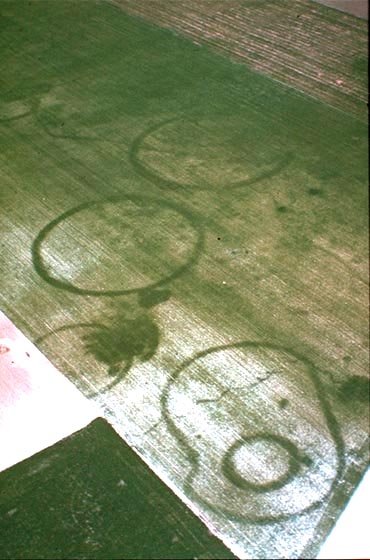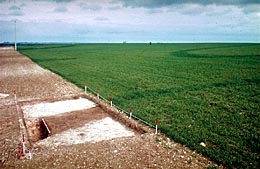- Home
- Clues on the ground
- Crop growth anomalies
At Noyelles-sur-Mer in the Somme, crop growth is more marked over ancient rubble. The aerial photograph reveals subcirculaire lines that correspond to moated enclosures from the Bronze Age.
Noyelles-sur-Mer (Somme), on the ground.
Crops that tell a story...
We speak of anomalies in crop growth (or phytographics clues) when there is a difference in the height and color of growing crops. Henri Delétang (1999) expressed it very well when he said that "the plants speak". In general, crop growth is more vigorous and more rapid over the site of ancient rubble, which is damper and more fertile. On the other hand, crops have a tendency to grow poorly over buried foundations. Nevertheless, under very exceptional atmospheric and meteorological conditions, the exact opposite can occur.
Drought is particularly favorable for these anomalies, especially when it occurs when the plants need water, i.e. when crops really start to push up vigorously.
Differences in crop growth
Under normal climatic conditions, crops, and grain crops in particular, provide the aerial archaeologist with good observation conditions, at a time when they are growing the fastest — and before there has been too much spreading of selective weedkillers and fertilizers, which quickly eliminate almost every difference.
At Noyelles-sur-Mer in the Somme, crop growth is more marked over ancient rubble. The aerial photograph reveals subcirculaire lines that correspond to moated enclosures from the Bronze Age. These ditches, which have slowly filled in over the years, make for more fertile soil. This explains why crops grow more vigorously in these areas. This is confirmed here by core samples. When arable soil is taken away, we can better understand that grain crops grow with difficulty in these clayish soils, although they grow much better over the site of the ancient ditch.
On the other hand, crops grow less well over the site of buried foundations, like at Remiencourt (Somme), where they are less well-developed over the chalk foundations of a small, Gallo-Roman temple. This can be seen when examining the soil: the crops are shorter and one can see white stones thrown up by the plow.
Remiencourt (Somme), discovery of the foundations of a small, leveled-off Gallo-Roman temple.
Remiencourt (Somme), ground-level view.




